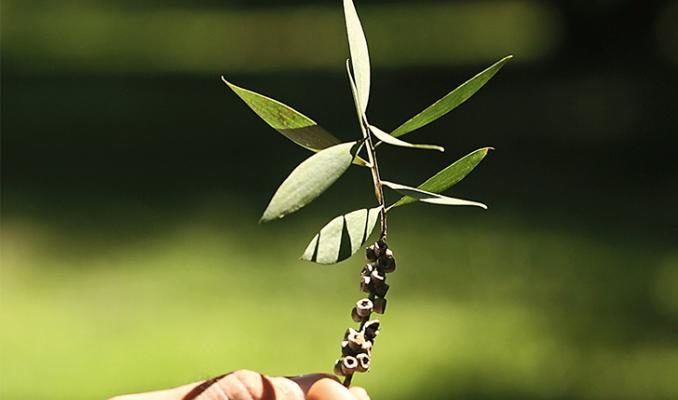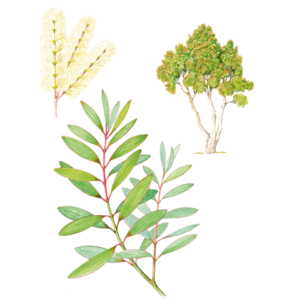
Find out more about the Niaouli plant of our Aromatherapy Herbarium blog series.

NIAOULI
Cajuput (Melaleuca cajuputi).
DESCRIPTION

Like eucalyptus, niaouli is a tree of the Myrtaceae family, native to New Caledonia and Australia, that can grow to a height of twenty five metres.
ADVICE
As essential oil of niaouli contains high levels of terpenes, the prescribed doses must be scrupulously respected. Warning: there is a risk of drug interference it the use exceeds more than a few days.
DO NOT USE IN
– pregnant or breast-feeding women,
– children under the age of three years,
– persons allergic to one of the components (geraniol, linalool, limonene),
– subjects with asthma without the advice of an allergologist before the first use,
– subjects with epilepsy (or children who have had fever seizures).
RECIPES
Burns
Mix the essential oil of niaouli 1:1 with rose hip carrier oil. Apply by massaging into the area to treat, three to four times per day until cured.
Muscle cramps
Mix 8 to 10 drops of essential oil of niaouli with one teaspoon of neutral carrier oil, then, after sports, massage painful areas.
Cold
Pour 3 to 5 drops of essential oil of niaouli into a bowl of hot water. Inhale for ten minutes.

It has persistent and fragrant leaves and its soft pale bark can be easily torn off like paper, thus leading to its also being known as the paper bark tree and nicknamed “skin tree”. It was acclimatised to Madagascar at the end of the 19th century to retimber marshland. Jules Garnier, who, during his geological explorations, discovered nickel in New Caledonia, came across niaouli in the west coast savannahs. In his travel account, he wrote “It is the saddest but most useful of trees on the island, as it hides its qualities and virtues under the most unhappy appearance.” But who cares whether their benefactor looks pitiful? Certainly not the Kanaks, who have always swaddled their newborns in its bark to protect them and give them strength. They applied a poultice of young niaouli leaves to wounds to speed healing. As a decoction, the bark was – and is still – used on the island to heal rheumatism pains, aches and colds.
CULTIVATION AND PRODUCTION
The tree is studied and used in New Caledonia by the Medicinal plants laboratory of the French national centre for scientific research (CNRS), in the context of the systematic exploration of the island’s extreme biodiversity. Essential oil of niaouli is used to manufacture Gomenol, a brand name medicinal product registered in 1892 by an industrialist established in Gomen, who was struck by the tree’s therapeutic virtues. It is comprised of partially deterpenated essential oil of niaouli, and is used to treat upper respiratory tract and bronchial congestion.
FRAGRANCE
The fragrance of essential oil of niaouli is balsamic, with a strong note of eucalyptus.
EXTRACTION AND YIELD
Leaf distillation yield is variable, though it does not exceed 0.7%, i.e. seven hundred grams for one hundred kilos of plant.
CHEMICAL FORMULA
Essential oil of niaouli consists mainly of terpene oxides (1,8-cineol: 38 to 48%), monoterpenols, sesquiterpenols including viridiflorol (6 to 15%) and monoterpenes (alpha and beta-pinene, limonene) that are eliminated to obtain “purified” oil. This composition corresponds to the essential oil from Madagascar, that from New Caledonia consisting mainly of sesquiterpenols (65 to 70%) and monoterpenols (approximately 20%).
MAIN INDICATIONS
Highly versatile, essential oil of niaouli stimulates the body’s immune defences. A wound healer, it protects and restores the skin. When inhaled, it treats sinusitis and rhinitis. It also possesses antiseptic, antiviral and antifungal properties. It can be generously applied to irradiated areas in the event of radiotherapy.


Leave a Comment